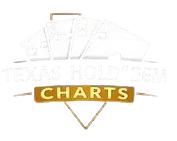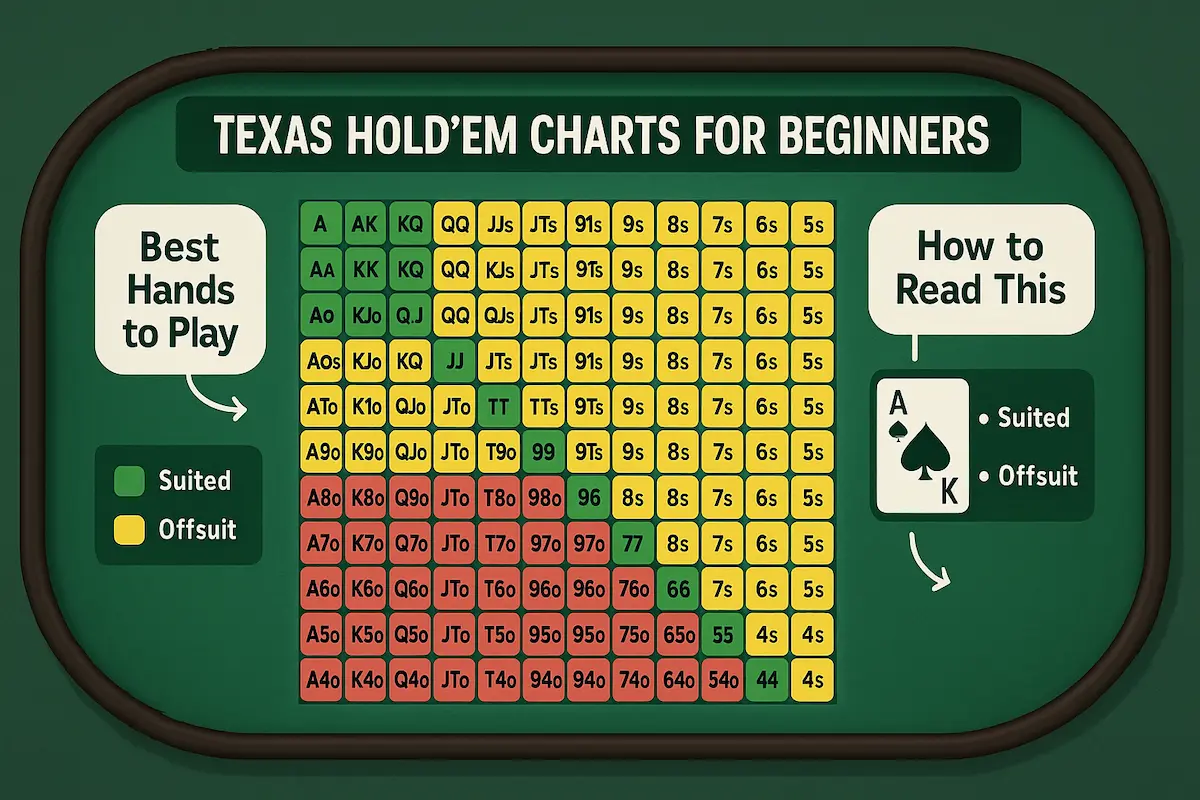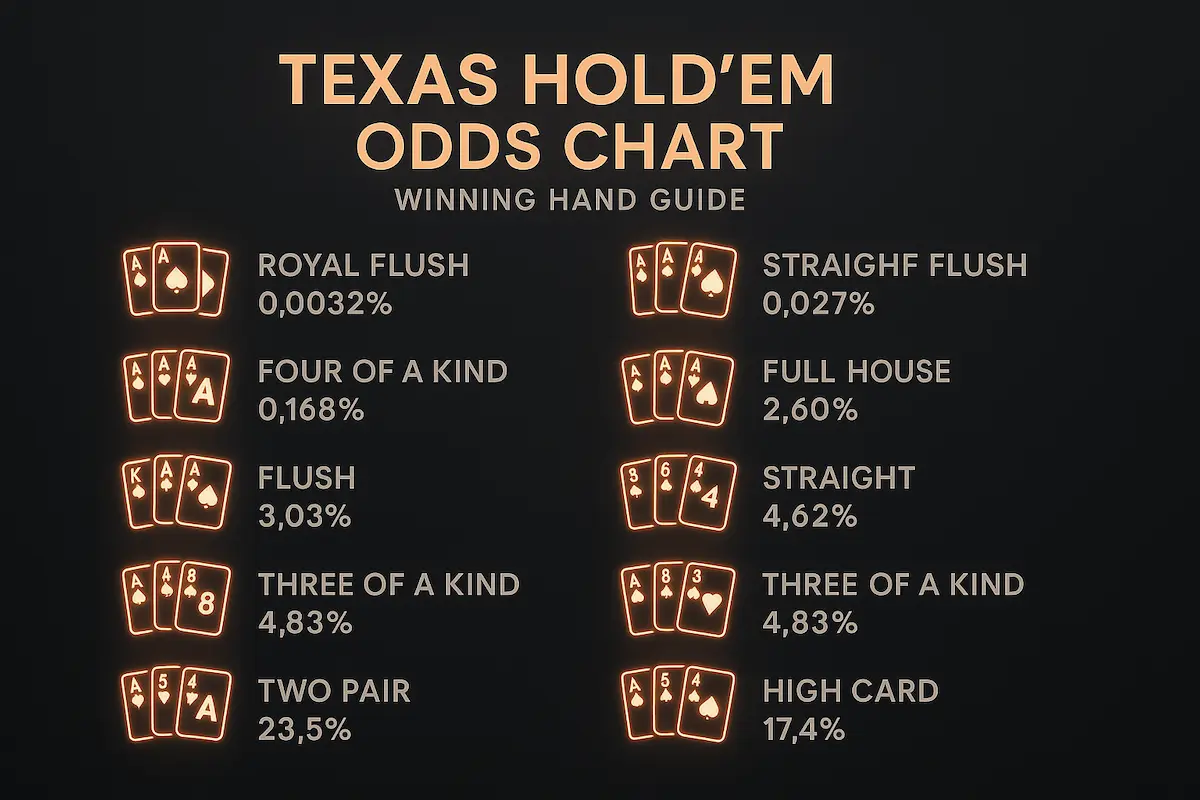Texas Hold’em is one of the most popular poker variants in the world, played in casinos, tournaments, and online platforms alike. Whether you’re a beginner or an aspiring pro, understanding and using Texas Hold’em charts is key to making smarter decisions and boosting your win rate.
In this guide, we’ll break down what Texas Hold’em charts are, how to use them effectively, and provide an in-depth look at Texas Hold’em chart hands, complete with hand rankings and strategy charts that help you play like a pro.
What Are Texas Hold’em Charts?
A Texas Hold’em chart is a visual representation of poker hands and strategies, used to guide decision-making during the game. These charts help players quickly determine the strength of their hand and whether to fold, call, raise, or go all-in, especially during pre-flop play.
Common Types of Texas Hold’em Charts:
-
Starting Hand Charts
-
Position-Based Hand Charts
-
All-in or Push/Fold Charts
-
EV (Expected Value) Charts
-
Range Charts for Opponent Profiling
Each type of chart serves a different purpose, depending on your skill level and table dynamics.
Want to download free printable charts? Try Upswing Poker or PokerStrategy.com for beginner-friendly PDFs.
Why Use a Texas Hold’em Chart?
Poker is a game of strategy, not guesswork. Using Texas Hold’em charts helps reduce emotional decisions and encourages mathematical consistency. The biggest benefits include:
-
Knowing which hands to play in each position
-
Avoiding weak starting hands
-
Identifying profitable spots to bluff or fold
-
Improving long-term expected value (EV)
-
Minimizing mistakes in high-pressure moments
Whether you’re in a live game or grinding online tournaments, having a Texas Hold’em hand chart at your fingertips increases confidence and discipline.
Texas Hold’em Chart Hands: Understanding Starting Hand Rankings
What Are Starting Hand Charts?
A starting hand chart lists all 169 possible starting hand combinations in Hold’em (13 ranks × 13 ranks) and classifies them by strength and playability. These combinations fall into three categories:
-
Pocket Pairs (e.g., AA, TT, 55)
-
Suited Hands (e.g., A♥K♥, J♠10♠)
-
Off-suit Hands (e.g., A♣K♦, Q♠J♦)
Sample Texas Hold’em Starting Hand Chart:
| Hand Type | Playability |
|---|---|
| AA, KK, QQ | Premium — Always raise |
| JJ, TT, 99 | Strong — Raise or call |
| AKs, AQs, KQs | Very strongly suited — Open from any position |
| AJo, KQo | Medium strength — Play from the middle or late position |
| 76s, 54s | Suited connectors — Use in late position or as a bluff |
Note: “s” = suited, “o” = off-suit
For a detailed look at all starting hands, visit PokerListings’ Starting Hand Chart.
Position-Based Texas Hold’em Charts
In poker, position is power. The later your position at the table (closer to the dealer button), the more information you have before acting. Texas Hold’em hand charts change depending on your position:
1. Early Position (EP) – Tight Range
-
Only play premium hands (AA–TT, AKs, AQs)
2. Middle Position (MP) – Slightly wider range
-
Add hands like AJ, KQ, QJs, 99, 88
3. Late Position (CO, BTN) – Looser Range
-
Play suited connectors, small pairs, suited aces (A9s, A8s), and bluff occasionally
4. Blinds (SB, BB) – Defensive and aggressive mix
-
Defend wide in BB, open tight in SB
Chart hands for each position helps structure your gameplay and improve your pre-flop strategy.
Push/Fold Charts: Perfect for Short-Stacked Play
When your chip stack drops below 10–15 big blinds, you enter the push/fold zone. In this scenario, using a push/fold chart can be the difference between survival and busting out.
These charts show you:
-
Which hands to go all-in with
-
When to fold based on stack size and position
For example:
-
From the Button with 10 BB, shove with: 22+, A2+, K8+, Q9s+, JTs
-
From Early Position with 8 BB, shove only: 66+, A9+, KQ
Download tournament push/fold charts from PokerNerve for free.
Equity and Range Charts: Advanced Usage
Advanced Texas Hold’em players study equity and ranges using specialized charts or poker solvers.
What is Equity?
Equity is your hand’s percentage chance to win at showdown against an opponent’s range.
For example:
-
AK suited vs 99 → ~46% equity
-
AQ off-suit vs JJ → ~30% equity
Range Charts
Range charts are used to assign possible hands to opponents based on their actions (e.g., 3-bet, call, fold). Tools like Equilab and Flopzilla visualize these ranges for optimal play.
These advanced tools complement Texas Hold’em chart hands and allow deep analysis of any situation.
How to Read and Use a Texas Hold’em Chart
A standard Texas Hold’em hand chart is structured as a 13×13 grid with rank combinations along the axes (2 through Ace).
Chart Reading Example:
-
Top-left (AA) = Pocket Aces (always raise)
-
Bottom-right (22) = Pocket Twos (play selectively)
-
Diagonal = Pocket pairs
-
Above diagonal = Suited hands (e.g., A♠K♠)
-
Below diagonal = Off-suit hands (e.g., A♣K♦)
Color-coded guides often use:
-
Green: Strong hands → Raise
-
Yellow: Medium hands → Call or raise in late position
-
Red: Weak hands → Fold
Once you memorize chart colors and positions, reading hand ranges becomes second nature.
Printable Texas Hold’em Charts: Where to Find Them
Here are reliable places to find free, printable Texas Hold’em hand charts:
These resources include charts for cash games, tournaments, and position-specific strategies—ideal for all levels.
Common Mistakes When Using Texas Hold’em Charts
-
Relying too strictly on charts without adapting to table dynamics
-
Ignoring opponent tendencies or table image
-
Using outdated or overly conservative charts
-
Misunderstanding suited vs. off-suit hands
Texas Hold’em charts are tools, not absolute rules. Combine them with experience and observation for best results.
Final Thoughts: Why Every Player Should Use Texas Hold’em Charts
Texas Hold’em is a blend of math, psychology, and timing. No matter your skill level, having a solid foundation in Texas Hold’em chart hands improves your decisions and reduces costly errors.
To recap:
-
Texas Hold’em charts guide pre-flop and post-flop strategy
-
Starting hand charts help choose playable hands
-
Push/fold charts are essential in short-stack tournament play
-
Position-based charts help exploit player advantage
-
Advanced players use range and equity charts for deeper strategy
Charts simplify complex decisions and help form habits that lead to long-term success at the poker table.



